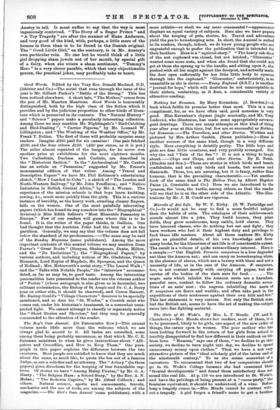Good Words. Edited by the Very Rev. Donald Macleod, D.D,
(Isbister and Co.)—The serial that runs through the issue of the year is Mr. Gilbert Parker's "Battle of the Strong." This has been noticed elsewhere. A short tale, " The Mother," comes from the pen of Mr. Maarten Maartens. Good Words is honourably distinguished, both by the high class of the fiction which it provides and by the judicious proportion to other kinds of litera- ture which is preserved in its contents. The " Natural History " and " Science " papers make a peculiarly interesting collection. Among these we may mention Mr. Nightingale's " Bird-Catching and Bird-Dealing " ; " Carrier Pigeons," by Mr. Leonard W. Lillingston ; and " The Working of the Weather Office," by Mr. Frank T. Bullen. The first of these will probably surprise many readers. Imagine £250 paid for six canaries ! One pair fetched £100, and the four others £150. (X50 per ounce, as it is put.) The seller almost repented of the bargain, for he never won another prize at exhibitions for the next eighteen months. Two Cathedrals, Durham and Carlisle, are described in the " Historical Section." In the " Archteological " Mr. Canton has an article on " Pausanias," suggested by Mr. Frazer's monumental edition of that writer. Among " Travel and Descriptive Papers" we have Mr. Phil Robinson's entertaining sketch, "How I Landed in Cuba " ; a sketch of " The London and North-Western Railway," by Mr. John Pendleton; and " Native Industries in British Central Africa," by Mr. A. Werner. The experience of the mission schools is that boys learn knitting, sewing, &c., much more quickly than the girls. This is a curious instance of heredity, as the heavy work, entailing clumsy fingers, falls on the women. One of the most painfully interesting papers (which has found its way somehow into the " Biographical " division) is Miss Edith Sellers's "Most Miserable Peasantry in Europe." Few of our readers will guess where this is to be found. It is, the writer of the paper thinks, in Gallicia. One had thought that the Austrian Poles had the best of it in the partition. Generally, we may say that the volume does not fall below the standard of its predecessors.—The same may be said of the Sunday Magazine (same publishers). Among the more important contents of this annual volume we may mention Dean Farrar's "Great Books" (Bunyan, Shakespeare, Dante, Milton, and the "De Imitatione") ; the "Biographical Papers," by various authors, and including notices of Mr. Gladstone, Prince Bismarck, Lord Napier of Magdala, Mr. Spurgeon, and the Queen of Holland ; Mrs. Molesworth's serial story, " The Laurel Walk ; " and the "Talks with Notable People," the "interview" accommo- dated, as far as may be, to good taste. Among the interesting personalities here presented to the reader are the veteran author of " Festus " (whose autograph is also given us in facsimile), two militant ecclesiastics, the Bishop of St. Asaph and Dr. C. A. Berry (one on either side, it should be observed), and Canon Barnett. Mr. Baring-Gould's " Village Characters " deserves to be specially mentioned, and so does his "St. Woolos," a Cornish saint who comes out, under his historian's treatment, in a somewhat unex- pected light. We cannot attempt to classify or separately notice the " Short Stories and Sketches," but they may be generally commended to the attention of the reader.






















































 Previous page
Previous page